Was Jim Toots guilty of first-degree murder? Or was Jim Toots guilty only of wearing skin of the wrong color and talking to the wrong woman in the wrong place at the wrong time? Or was there some gray zone between black and white?
In 1892 Fort Worth police officers C. L. Waller and H. C. Townes were partners on the beat in what the Dallas Morning News called “the very lowest and toughest district of the city”: Hell’s Half Acre.
On the night of June 28 Waller and Townes were patrolling in the Acre when they saw two African Americans—a man and a woman—in an alley on East 12th Street.
 Just as segregated Fort Worth had a white downtown and a black downtown, so was the Acre segregated, with most of the African-American businesses and tenements on the eastern edge of the Acre. This 1893 Sanborn map shows “Negro tenements” and “female boarding” houses (brothels) in the area of Calhoun and East 12th streets.
Just as segregated Fort Worth had a white downtown and a black downtown, so was the Acre segregated, with most of the African-American businesses and tenements on the eastern edge of the Acre. This 1893 Sanborn map shows “Negro tenements” and “female boarding” houses (brothels) in the area of Calhoun and East 12th streets.
The two African Americans in that alley that night in 1892, officer Townes would later testify, were Lou Davis and Jim Burris, alias “Jim Toots.”
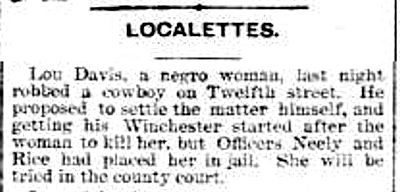 Lou Davis, like Jim Toots, was well known to police in the Acre. Clip is from the May 25, 1891 Gazette.
Lou Davis, like Jim Toots, was well known to police in the Acre. Clip is from the May 25, 1891 Gazette.
Officer Townes later testified: “We were walking along Twelfth and when we got to the alley we saw Toots and Lou Davis, a negro woman, about seven or eight feet from the sidewalk. . . . Lou Davis is a negro prostitute. She was standing with her arms on Toots’s shoulder or around his neck. . . . When Waller saw them he told Lou to come out. Toots said, ‘What’s the matter with you; I’ll be shoving a rock out there after you.’ ‘I’ll be shoving something else back at you,’ Waller replied.”
(The Dallas Morning News would claim that Toots said, “Keep away from me or I’ll blow a hole through you.”)
Freeze frame. Just a typical night in the Acre, right? Just two members of a white police force confronting two African Americans, the woman an Acre prostitute and thief, the man an Acre gambling house owner, right?
Except, local historians Dr. Richard Selcer and retired police sergeant Kevin Foster write in Written in Blood (Volume 1), black prostitute Lou Davis was white police officer C. L. Waller’s “paramour.”
So.
Was that fact merely an “oh, by the way . . .” irrelevancy, or did it shape the dynamics of that night’s events—events that would cause that Acre alley to stretch all the way to the Capitol steps in Austin?
Officer Townes testified that there in that alley Waller and Toots cursed each other. A scuffle ensued. Waller struck Toots with his nightstick. Townes intervened; Toots retreated down the street.
End of encounter.
Or was it?
Jim Toots, Selcer and Foster write, began looking for a gun and some reinforcements among the Acre’s African-American population. Lou Overton, who owned an African-American saloon on Rusk (now Commerce) Street in the Acre, testified: “Toots was out in the street cursing the officers, and making threats that he would kill the brass-buttoned sons of bitches; that they couldn’t walk their beats and live . . . that he didn’t have an even break with them.”
Toots finally procured a pistol from an unlikely donor: Fort Worth police officer Tom Snow, who moonlighted as a bartender in the Acre. Toots also enlisted Horace Bell and Willie Campbell, two black men of the Acre who had reason to resent the way they had been treated by white policemen.
Meanwhile, officers Waller and Townes recruited their own reinforcement—officer Frank Bryant—and began searching the Acre for Toots. Soon, just after midnight (on June 29), Waller and company were walking south on Rusk; Jim Toots and company were walking north on Rusk. Toots and company shot first, Selcer and Foster write, taking the three officers by surprise near the Southern Livery Stables (about where Commerce Street today curves around the Convention Center dome).
Amazingly, with two three-man teams firing at each other, only Waller was hit. And he was hit three times. Toots and his men fled. Officer Townes helped Waller walk to the firehouse on Main Street. Waller collapsed from his wounds and exclaimed, the Dallas Morning News said, “Boys, I’m a goner.”
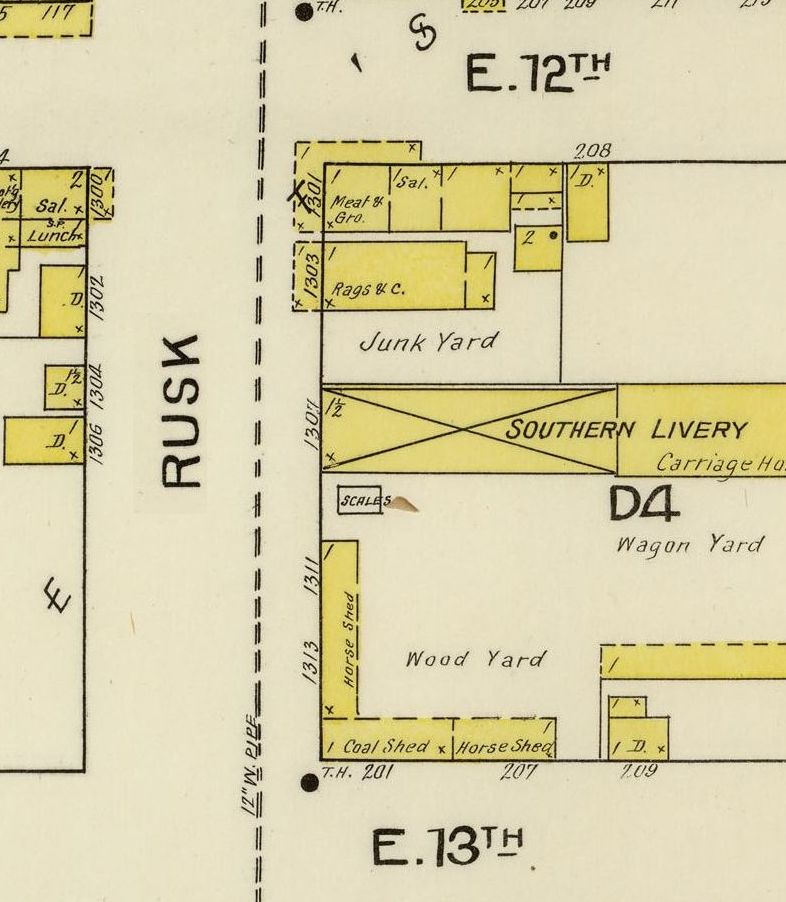 This 1893 Sanborn map shows the location of the shootout on Rusk Street between 12th and 13th streets. Lou Overton’s saloon was opposite the Southern Livery Stables. He witnessed the shootout.
This 1893 Sanborn map shows the location of the shootout on Rusk Street between 12th and 13th streets. Lou Overton’s saloon was opposite the Southern Livery Stables. He witnessed the shootout.
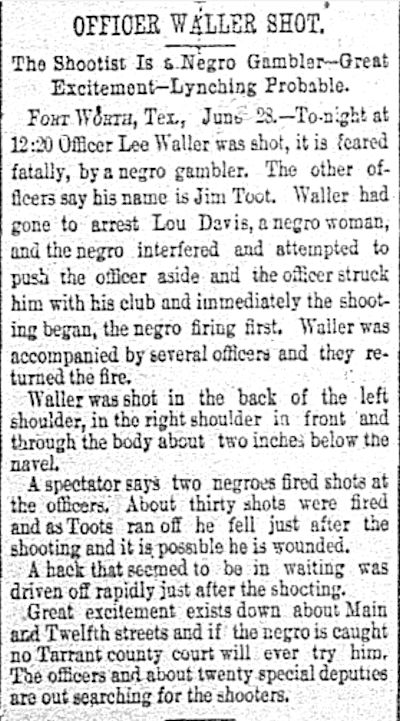 Fort Worth’s reaction was immediate and intense. The Dallas Morning News headline on June 29 was “Lynching Probable.” This early account has some inaccuracies.
Fort Worth’s reaction was immediate and intense. The Dallas Morning News headline on June 29 was “Lynching Probable.” This early account has some inaccuracies.
 The Dallas Morning News headline on June 30 was “Almost a Lynching.” “Not since the memorable days which marked the course of the railroad riot of 188[6] have the citizens of this city been so thoroughly aroused and excited,” the lead paragraph said. This early account, too, has some inaccuracies.
The Dallas Morning News headline on June 30 was “Almost a Lynching.” “Not since the memorable days which marked the course of the railroad riot of 188[6] have the citizens of this city been so thoroughly aroused and excited,” the lead paragraph said. This early account, too, has some inaccuracies.
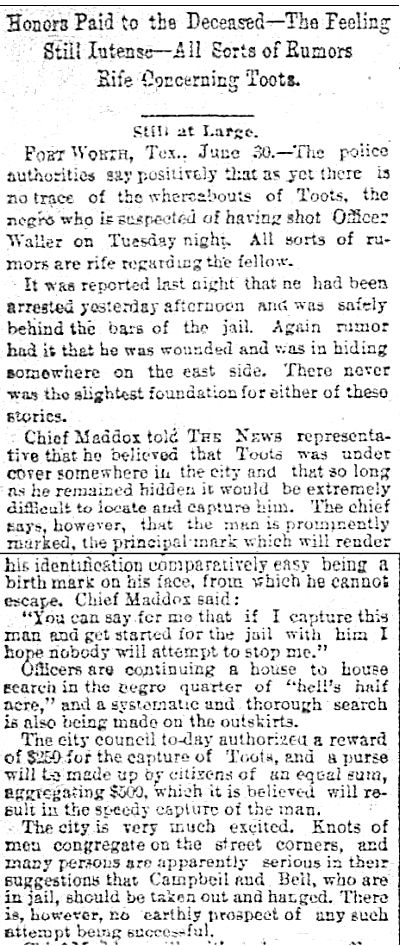 Officer C. L. Waller was taken to the Missouri Pacific Infirmary in the care of Dr. William A. Duringer but died on June 30.
Officer C. L. Waller was taken to the Missouri Pacific Infirmary in the care of Dr. William A. Duringer but died on June 30.
While the city mourned and fumed, Jim Toots remained at large. On July 1 the Dallas Morning News continued to report talk of lynching. The newspaper quoted Police Chief Jim Maddox as saying of Toots, “. . . if I capture this man and get started for the jail with him, I hope nobody will attempt to stop me.”
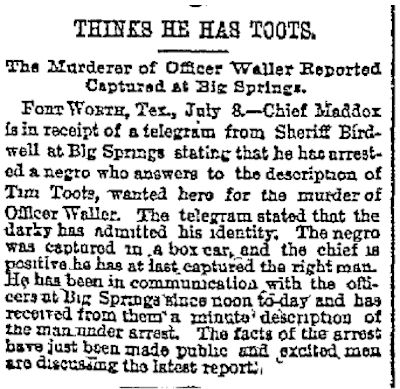 Bell and Campbell, Toots’s reinforcements, were quickly arrested, jailed, and charged with being accomplices in the killing of Waller. But as Toots remained at large, the next week was full of the predictable angry mobs, wild rumors, and false sightings. But on July 8 the Morning News announced that the sheriff of Howard County (Big Spring) had captured Jim Toots in a boxcar.
Bell and Campbell, Toots’s reinforcements, were quickly arrested, jailed, and charged with being accomplices in the killing of Waller. But as Toots remained at large, the next week was full of the predictable angry mobs, wild rumors, and false sightings. But on July 8 the Morning News announced that the sheriff of Howard County (Big Spring) had captured Jim Toots in a boxcar.
The three suspects did not go on trial until 1893. Bell and Campbell were convicted and sentenced to prison—ninety-nine years for Bell, fourteen for Campbell. Both men would die in prison. During Toots’s trial he took the stand to plead self-defense and, predictably, told a different story than that told by the police. Toots said that when officers Waller and Townes confronted him and Lou Davis in that Acre alley, Waller drew a pistol and threatened to shoot Toots. Toots admitted to later procuring a gun but only for self-defense against Waller. Toots said that Waller and two other officers came to his boardinghouse on Calhoun Street looking for him, that he hid and heard the officers say, “We will kill the damn son of a bitch.” Toots said he was on his way to a saloon to hide when he saw the three officers coming toward him on Rusk Street. Toot claimed that Waller shot first. Toots claimed that he shot Waller in self-defense.
(Officer Waller was wearing badge 13. In 1902 officer Andy Grimes would be shot to death while wearing badge 13.)
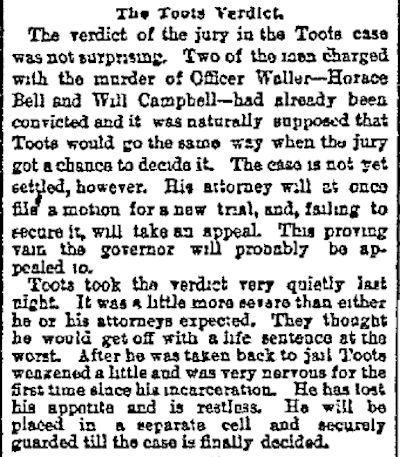 On March 25, 1893 Jim Toots was found guilty of first-degree murder and sentenced to hang. Clip is from the March 27 Morning News.
On March 25, 1893 Jim Toots was found guilty of first-degree murder and sentenced to hang. Clip is from the March 27 Morning News.
At this point Toots, who had been given court-appointed attorneys, was given a self-appointed angel. James Swayne (attorney, city attorney, state senator) had been following the murder case. Swayne took the Toots conviction to the appellate court.
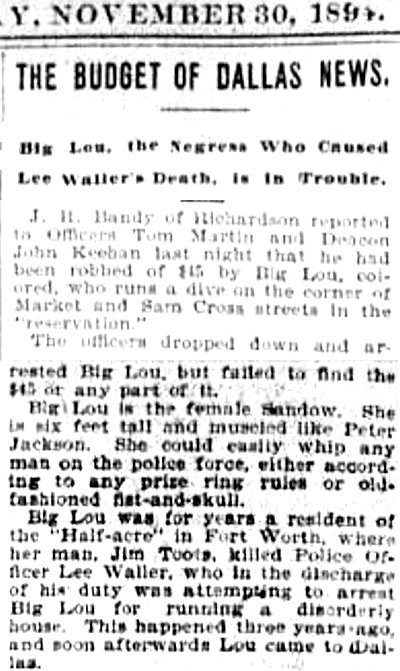 Meanwhile, Lou Davis had moved to Dallas, where she was known as “Big Lou.” (Sandow was a German bodybuilder. Peter Jackson was a boxer.) Clip is from the November 30, 1894 Gazette.
Meanwhile, Lou Davis had moved to Dallas, where she was known as “Big Lou.” (Sandow was a German bodybuilder. Peter Jackson was a boxer.) Clip is from the November 30, 1894 Gazette.
 On October 16, 1895 the conviction and sentence of Jim Toots were upheld. But James Swayne vowed to seek a commutation. Swayne said: “The hanging of Jim Toots will be nothing less than legalized murder. I am as thoroughly convinced that he acted in self-defense as I am in my own existence.” Swayne said he had found a witness who would swear that he had heard Waller vow to kill Toots. Clip is from the October 17, 1895 Dallas Morning News.
On October 16, 1895 the conviction and sentence of Jim Toots were upheld. But James Swayne vowed to seek a commutation. Swayne said: “The hanging of Jim Toots will be nothing less than legalized murder. I am as thoroughly convinced that he acted in self-defense as I am in my own existence.” Swayne said he had found a witness who would swear that he had heard Waller vow to kill Toots. Clip is from the October 17, 1895 Dallas Morning News.
Swayne went to Austin to plead with the pardons board. Among those Fort Worth citizens who wrote letters to the governor on behalf of Toots were K. M. Van Zandt, J. C. Terrell, Martin Bottom Loyd, William Pinckney McLean, the law firm of Capps and Cantey, and, perhaps most interesting, Ephraim Beck “Bud” Daggett, father of Jeff Daggett (see photos below).
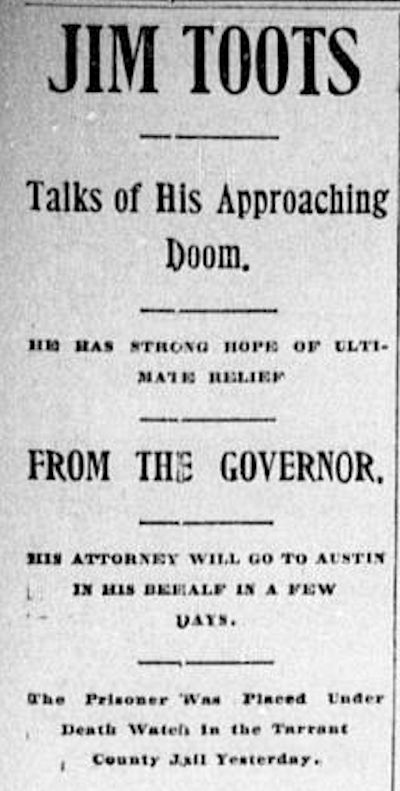 The November 11, 1895 Gazette reported that Toots had hope even as he was placed under a death watch.
The November 11, 1895 Gazette reported that Toots had hope even as he was placed under a death watch.
 Swayne presented to the pardons board a sworn statement of a man who said he had witnessed the first Waller-Toots encounter on the night of June 28 and had heard Waller say that he was going to kill Toots and that “Toots was interfering with his [Waller’s] woman.” Clip is from the December 7, 1895 Gazette.
Swayne presented to the pardons board a sworn statement of a man who said he had witnessed the first Waller-Toots encounter on the night of June 28 and had heard Waller say that he was going to kill Toots and that “Toots was interfering with his [Waller’s] woman.” Clip is from the December 7, 1895 Gazette.
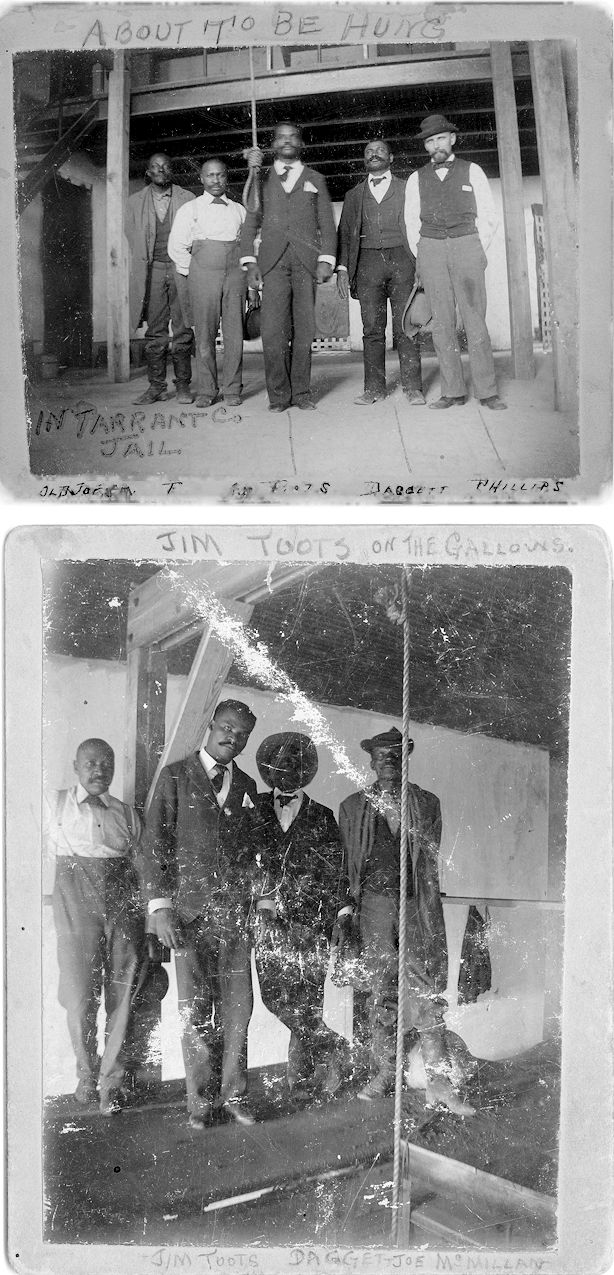 As Jim Toots awaited his fate, someone with a macabre sense of humor had Toots pose on the Tarrant County gallows. The identification of the men in “About to be hung”: Joe McMillan, unknown, Jim Toots, Jeff Daggett, Phillips (possibly a jailer). The identification of the men in “Jim Toots on the gallows”: unknown, Jim Toots, Jeff Daggett, Joe McMillan. (Photos from University of Texas at Arlington Library.)
As Jim Toots awaited his fate, someone with a macabre sense of humor had Toots pose on the Tarrant County gallows. The identification of the men in “About to be hung”: Joe McMillan, unknown, Jim Toots, Jeff Daggett, Phillips (possibly a jailer). The identification of the men in “Jim Toots on the gallows”: unknown, Jim Toots, Jeff Daggett, Joe McMillan. (Photos from University of Texas at Arlington Library.)
 But Jim Toots would have the last laugh. On December 21, 1895, with Toots scheduled to hang before Christmas, Governor Charles Allen Culberson played Santa, commuting Toots’s death sentence to a life sentence.
But Jim Toots would have the last laugh. On December 21, 1895, with Toots scheduled to hang before Christmas, Governor Charles Allen Culberson played Santa, commuting Toots’s death sentence to a life sentence.
James Swayne ticked off points that had swayed the governor, among them: that Waller had beaten and pulled a gun on Toots, that Waller had threatened to kill Toots, that Toots had been warned of Waller’s threat. Clip is from the December 22, 1895 Gazette.
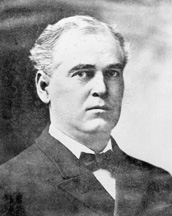 Charles Allen Culberson is buried in Oakwood Cemetery. (Photo from Wikipedia.)
Charles Allen Culberson is buried in Oakwood Cemetery. (Photo from Wikipedia.)
Jim Toots began serving his sentence at Huntsville early in 1896.
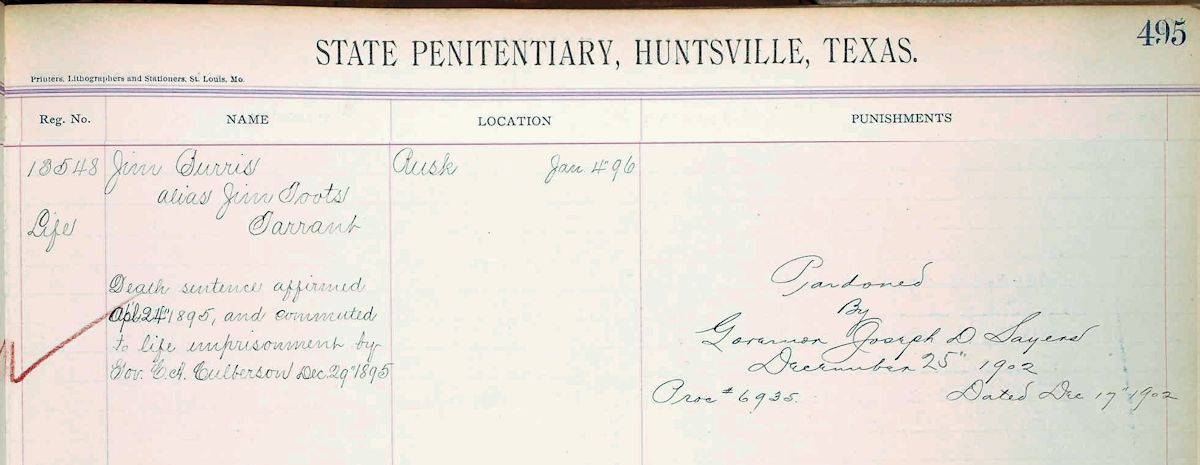 Fast-forward to Christmas Day 1902. Enter Santa II. Governor Joseph Sayers pardoned Jim Toots, citing, Selcer and Foster write, “deep prejudice against defendant as to preclude a fair and impartial trial.” Selcer and Foster also write that Governor Sayers cited the relationship between officer Waller and Lou Davis.
Fast-forward to Christmas Day 1902. Enter Santa II. Governor Joseph Sayers pardoned Jim Toots, citing, Selcer and Foster write, “deep prejudice against defendant as to preclude a fair and impartial trial.” Selcer and Foster also write that Governor Sayers cited the relationship between officer Waller and Lou Davis.
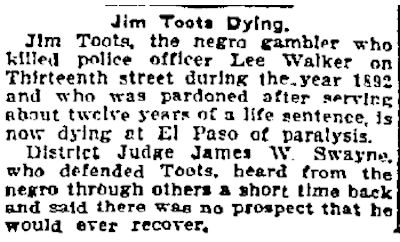 A free man again, Jim Toots returned to Fort Worth but soon sought the safety of obscurity. This August 14, 1909 Star-Telegram brief ends his story: Jim Toots, his health failing, was last heard of in El Paso. But he left behind a story of brass buttons and bad blood in Fort Worth’s “very lowest and toughest district of the city.”
A free man again, Jim Toots returned to Fort Worth but soon sought the safety of obscurity. This August 14, 1909 Star-Telegram brief ends his story: Jim Toots, his health failing, was last heard of in El Paso. But he left behind a story of brass buttons and bad blood in Fort Worth’s “very lowest and toughest district of the city.”
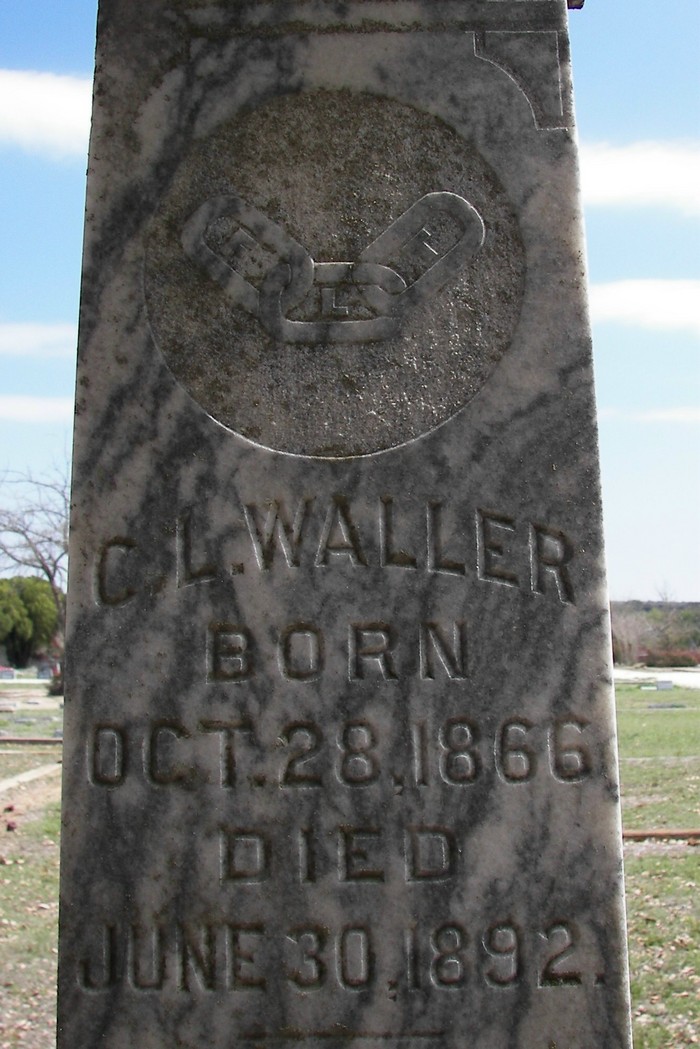 Officer Waller is buried in Hico Cemetery in Hamilton County. (The three links of chain are an Odd Fellows lodge symbol: F for “friendship,” L for “love,” T for “truth.”)
Officer Waller is buried in Hico Cemetery in Hamilton County. (The three links of chain are an Odd Fellows lodge symbol: F for “friendship,” L for “love,” T for “truth.”)
![]() His name is engraved on the wall of the Fort Worth Police and Firefighters Memorial in Trinity Park.
His name is engraved on the wall of the Fort Worth Police and Firefighters Memorial in Trinity Park.
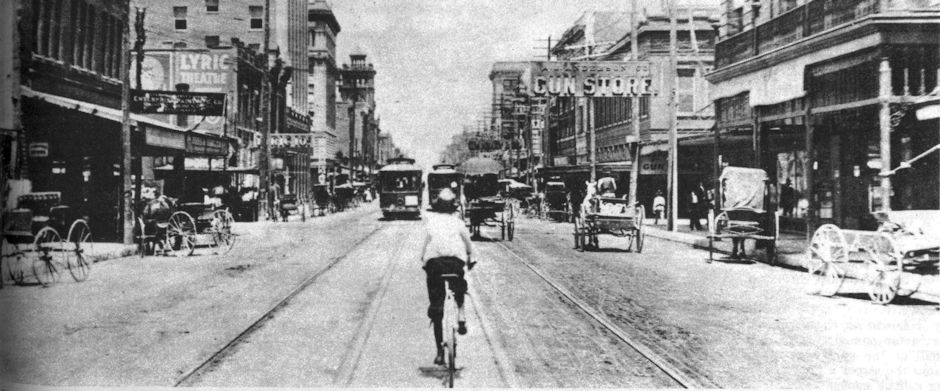





Thanks for sharing your thoughts on Fort Worth.
Regards
I apologize. I see my “fire emojis” were not recognized and replaced with question marks. But have no questions about it, that story of Big Lou, Toots, and Officer Waller was FIRE!!!
Thanks, Don. I tried to copy and paste an emoji and also tried the unicode for a flame. Did not work. WordPress apparently accepts a few emoji codes, but the flame is not one of them. 🙁
Good read, Mike. Is that person riding the bike down the street one of your ancestors?
Thanks. If he is an ancestor, that’s probably a stolen bike. But I love that photo.